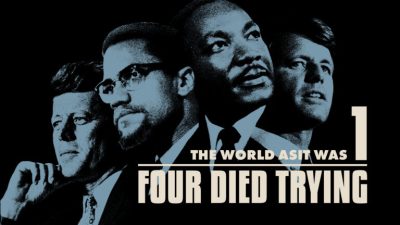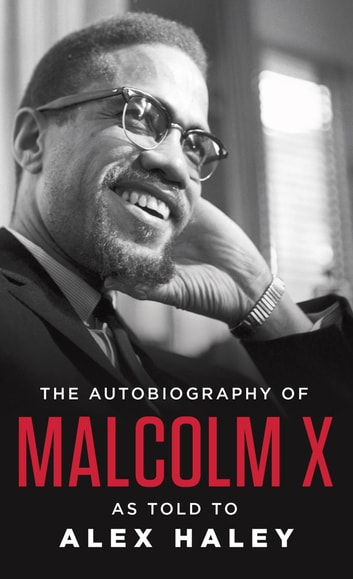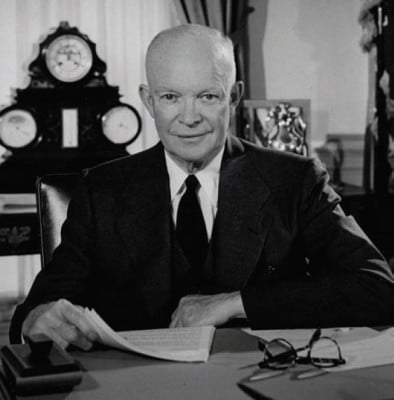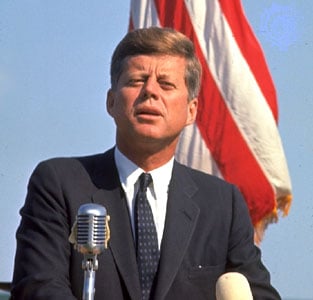“The World As It Was”: A Masterly Documentary Film

All Global Research articles can be read in 51 languages by activating the Translate Website button below the author’s name (only available in desktop version).
To receive Global Research’s Daily Newsletter (selected articles), click here.
Click the share button above to email/forward this article to your friends and colleagues. Follow us on Instagram and Twitter and subscribe to our Telegram Channel. Feel free to repost and share widely Global Research articles.
Global Research Fundraising: Stop the Pentagon’s Ides of March
***
Here’s a film about the 1950s – “The World As It Was” – that will tell you a great deal about life in the U.S.A. today, while disabusing anyone of the notion that nostalgia for that mephitic decade is in order, for it was a time when “democracy” tended toward totalitarianism.
In doing so, it sowed the bitter fruit that is poisoning us today. Without understanding the long-standing effects of those years, it is impossible to grasp the deepest dimensions of our current nightmare.
Chapter One of the documentary series, Four Died Trying, directed by John Kirby and produced by Libby Handros, appropriately subtitled: “To see where we are, look where we’ve been,” does that brilliantly.
 The series opened four months ago with “The Prologue” (see review) wherein the lives, importance, and assassinations of John F. Kennedy, Malcolm X, Martin Luther King, Jr., and Robert F. Kennedy are explored;
The series opened four months ago with “The Prologue” (see review) wherein the lives, importance, and assassinations of John F. Kennedy, Malcolm X, Martin Luther King, Jr., and Robert F. Kennedy are explored;
How the government and media buried the truth of who assassinated them and why; and why it matters today.
Season One will unfold over the next year with chapters covering their lives and assassinations in greater detail. Season Two will be devoted to the government and media coverups, citizen investigations, and the intelligence agencies and their media mouthpieces’ mind control operations aimed at the American people that continue today.
Chapter One – “The World As It Was” – is about the 1950s, the rise of the Cold War with its propaganda, McCarthyism, the development of the military-industrial complex, the CIA, red-baiting, betrayals, blacklists, the abrogation of civil rights, censorship, and the ever present fear of nuclear war and the promotion of fallout shelters that set the stage for the killing fields of the 1960s and the CIA’s ruthless machinations.
One could say that the 1950s were the Foundation of Fear upon which the horrors of the 1960s were built, and that now we are reaping the flowers of evil that have sprung up everywhere we look because the evils of those decades have never been adequately addressed.
 The film opens with President Eisenhower delivering his famous Farewell Address, warning about the growing power of the military-industrial complex.
The film opens with President Eisenhower delivering his famous Farewell Address, warning about the growing power of the military-industrial complex.
It is a short and powerful speech, concealing not a smidgen of hypocrisy since it must not have been Eisenhower who presided for eight years from 1953-1961 as this complex grew and grew and he poured 2 billion dollars in weapons and aid and a thousand military advisers to the ruthless and corrupt Vietnamese dictator Ngô Dinh Diêm, while saying he was “an example for people everywhere who hate tyranny and love freedom.”
His speech, while still good, reminds me of all those who spend their careers quiet as church mice as the wars and assassinations rage on only to find their voices in opposition once they retire and collect their pensions.
Watch the trailer below.
In response to Eisenhower’s speech, some of which we hear, Robert F. Kennedy, Jr. – one of a hundred interviews done for this series over six years – says that Eisenhower’s speech “is probably today in retrospect the most important speech in American history.”
While that is debatable (I would pick JFK’s American University speech), he rightly emphasizes the importance of Ike’s speech and the fact that his uncle, President Kennedy, fought against the military-industrial complex handed him by Eisenhower.
 This is important, for although JFK did get elected emphasizing the Cold War rhetoric of a non-existent missile gap between the U.S. A. and the Soviet Union, he very quickly changed, having been betrayed by Allen Dulles and the CIA regarding the Bay of Pigs, the assassination of Patrice Lumumba, Vietnam, Laos, etc.
This is important, for although JFK did get elected emphasizing the Cold War rhetoric of a non-existent missile gap between the U.S. A. and the Soviet Union, he very quickly changed, having been betrayed by Allen Dulles and the CIA regarding the Bay of Pigs, the assassination of Patrice Lumumba, Vietnam, Laos, etc.
The military brass quickly came to hate Kennedy, a naval war hero from World War II. His three year transformation into a great peacemaker – and therefore his assassination by the CIA and its friends – is a story many still would like to squelch. This documentary series will prevent that.
Those who control our present and wish to control our future are hard at work today trying to control our past and they will therefore hate this truthful film that is a powerful antidote to their attempted amnesia. In thirty-nine sobering and entertaining minutes (with emphasis on both words),
“The World As It Was” illuminates a period in U.S. history that is often dismissed as the staid and boring 1950s but was in fact when the infrastructure for today’s censorship, chaos, and fear was laid. It was not the era, as a baseball movie about Jimmy Piersall and his depression from 1957 put it, when “Fear Strikes Out,” but the time when fear burrowed very deep into the American psyche and anxiety became a weapon of state. Is it any wonder that today could be called “the age of depression, fear, anxiety, and pill popping”?
It is interesting to note that Eisenhower’s warning also contained an admonition to beware the growth of unchecked science, technology, and a future when computers would replace blackboards.
If he were still alive, he would no doubt not recognize the country controlled by what former CIA analyst Ray McGovern calls the Military-Industrial-Congressional-Intelligence-Media-Academia-Think-Tank complex (MICIMATT).
This vast computer-networked monster makes all the warnings about the 1950s snooping, informing, and controlling activities of government agencies seem like child’s play. They can’t open snail mail now when few send any, but reading computer messages barely necessitates a finger’s movement, or, as Edward Snowden continues to warn, the entire electronic phone system is open sesame for government controllers. Cell phones acting as cells. Blackboards are gone but so is privacy. The 1950s’ government snooping is pure nostalgia now. We are through the looking glass.
As then, so today. Oliver Stone talks about how in those days the constant refrain was “the Russians are coming” and how his father, a Republican stockbroker, told him that “the Russians are inside the country.”
Fear was everywhere, all induced by anti-communist propaganda aimed at controlling the American people. Stone is still fighting against the Russia bogeyman stories, while today we are told again and again that the Russians are still coming. We can only assume they are very slow.
Aside from RFK, Jr. and Oliver Stone, in this episode we hear from NYU Professor Mark Crispin Miller, Kathleen Kennedy Townsend, the screenwriter Zachary Sklar, et al.
Because the film is so ingeniously crafted, many of the most powerful voices – for and against the government repression and fear mongering – are those from newsreels and television shows that are artfully spliced between the commentaries of the aforementioned people. For example, to see and hear FBI Director J. Edgar Hoover rant about communists under every bed and to juxtapose that with the calm words of the filmmaker Dalton Trumbo, blackballed as one of the so-called Hollywood Ten, is an exercise in distinguishing sanity from insanity.
To this is added music, advertisements, movie clips, and jingles from the 1950s culture that place the viewer back in time to feel and absorb the “vibes,” as it were, of those days.
Like any era, it was complicated, but the overriding message from the fifties was not about mom making tuna noodle casserole but was that there were commie traitors everywhere throughout society and that every citizen’s obligation was to turn them in, even if that meant turning yourself or your parents in. Children were taught to get under their desks when the sirens sounded, for they were safe places when the Commie Nukes start coming in. Civil Defense drills screeched this fear into your every fiber. In April 1957 the Army Air Defense Command announced that new Nike Hercules missiles with atomic warheads would shortly be installed around New York City, Boston, Providence, etc. to replace conventional warheads. A spokesman added that these nuclear warheads posed no danger and that if the missiles were used, fallout would be “negligible.” Of course.
Let me use an anecdote from pop culture that I think sums this up this sick game of fear and distrust – paranoia. My parents were on a game show in the fall of 1957 called “Do You Trust Your Wife?” hosted by Johnny Carson.
By the summer of 1958 the show’s title was changed to “Who Do you Trust?” I used to joke that Hoover or Senator Joseph McCarthy was behind the change and their English grammar was atrocious, but I realize it was probably some fearful lackeys in the television industry.
Professor Miller, an expert in propaganda, narrates quite a bit of “The World As It Was” and does so admirably. He correctly points out that to describe the 1950s as the era of McCarthyism is a misnomer, for doing so “let’s the whole system off the hook.” It was the entire government apparatus that promoted a vast repression based on fear whose aim was to create meek, deferential, and obedient people afraid of their own shadows.
He points out that the basis for all this was established by President Truman in 1947 with his Executive Order 9835 that required loyalty oaths to root out communists in the federal government. Six months later the CIA was founded and the country was off to the Cold War races with its anti-communist hysteria and the institutionalization of a militarized society.
The Red Menace, nuclear extinction, and the need to root out those traitors who were conspiring to overthrow the U.S. government by force were pounded into people’s minds. Not only were these traitors in the government, but in the schools and colleges, the labor and racial equality movements – more or less everywhere. Whom could you trust? No one, not even yourself. While McCarthy was eventually censored for going too far when Joseph Welch accused him of having no decency during the 1954 Army-McCarthy hearings, he accomplished the goal of injecting his paranoic poison into the social bloodstream where it remains today, part of the political structure shared by both major parties.
But hope arose, as the film concludes, when JFK was elected in 1960 and in his first week in office went to the theater to see the blackballed screenwriter’s Dalton Trumble’s adaptation of Howard Fast’s novel, Spartacus, about a slave revolt in ancient Rome. Fast was also blacklisted and wrote the novel secretly. As RFK, Jr. says, this was a symbolic turning point when it was reported on the front page of The New York Times.
“It [the film Spartacus] is a parable of resistance and heroism that speaks unreservedly to our own times,” wrote the great journalist John Pilger in We Are Spartacus shortly before his death. “There is one ‘precise’ provocateur now; it is clear to see for those who want to see it and foretell its actions. It is a gang of states led by the United States whose stated objective is ‘full spectrum dominance’. Russia is still the hated one, Red China the feared one.”
Yes, today we are told that the Russians are still coming. The bad old days are back. But so also is the slaves’ rebellion.
Four Died Trying is a documentary series that is part of this rebellion. Chapter One, “The World As It Was” shines a very bright light on disturbing U.S. history. It shows where we have been in order to help us see where we are. Don’t miss it.
Watch the trailer below.
*
Note to readers: Please click the share button above. Follow us on Instagram and Twitter and subscribe to our Telegram Channel. Feel free to repost and share widely Global Research articles.
This article was originally published on the author’s website, Behind the Curtain.
Edward Curtin is a prominent author, researcher and sociologist based in Western Massachusetts. He is a Research Associate of the Centre for Research on Globalization (CRG).

